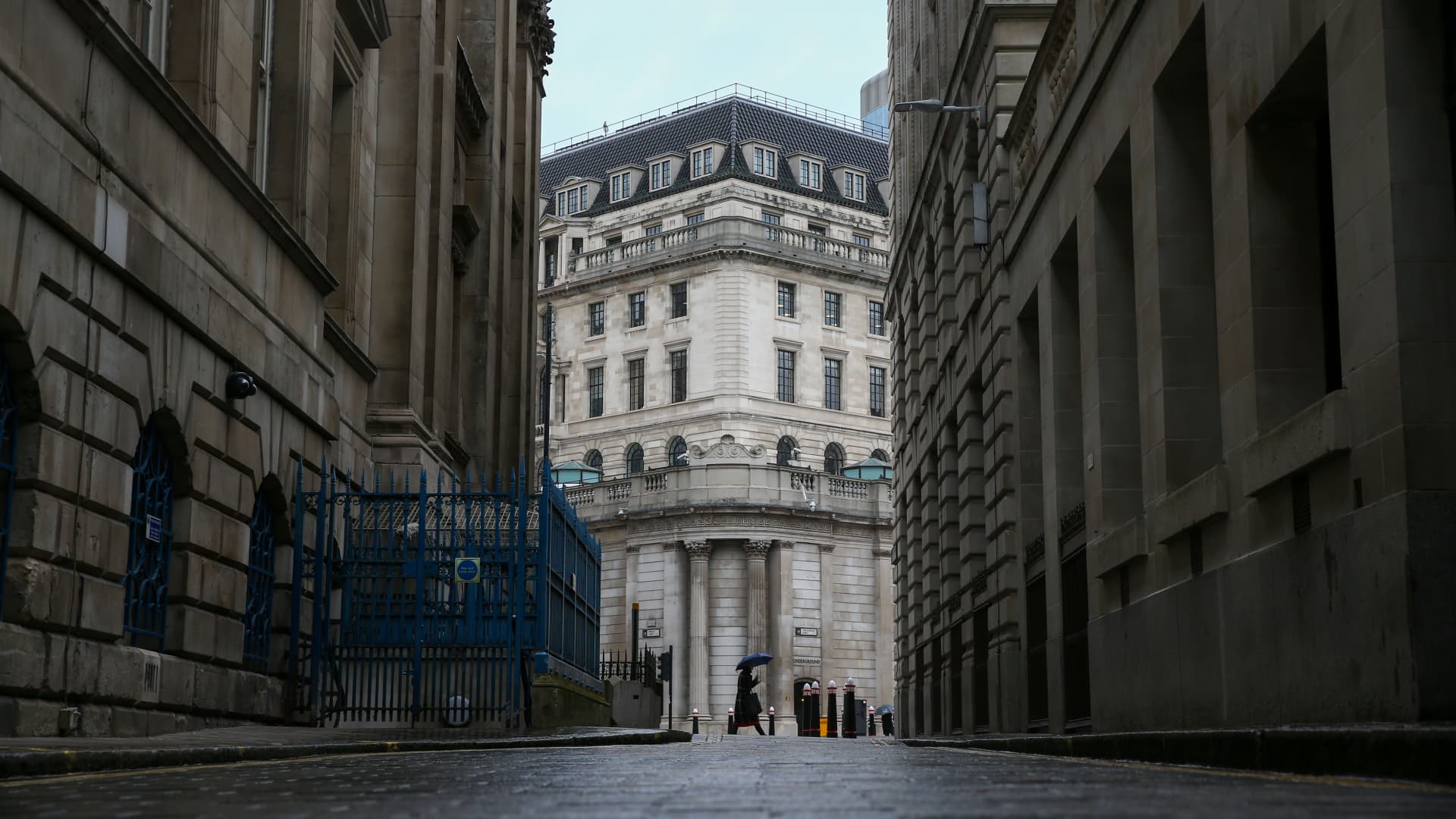A passageway near the Bank of England (BOE) in the City of London, U.K., on Thursday, March 18, 2021.
Hollie Adams | Bloomberg | Getty Images
LONDON — The Bank of England held interest rates steady at 5.25% on Thursday, with the announcement detailing the very divided opinions among board members.
The Monetary Policy Committee voted 6-3 in favor of holding rates, with two dissenters favoring a further 25 basis point hike and one voting for a quarter-point cut. This marked the first meeting since August 2008 that MPC members have voted to move interest rates in opposite directions at the same meeting.
“The MPC remains prepared to adjust monetary policy as warranted by economic data to return inflation to the 2% target sustainably,” the bank said in a statement.
“It will therefore continue to monitor closely indications of persistent inflationary pressures and resilience in the economy as a whole, including a range of measures of the underlying tightness of labour market conditions, wage growth and services price inflation. On that basis, the Committee will keep under review for how long Bank Rate should be maintained at its current level.”
Sterling recouped the day’s losses against the dollar to trade roughly flat by early afternoon in London, at around $1.2677 to the pound.
Much of the market focus of late has been on when the central bank will start cutting interest rates from their current 15-year high.
U.K. headline inflation unexpectedly nudged upward to an annual 4% in December on the back of a rise in alcohol and tobacco prices, while the closely watched core consumer price index figure was unchanged at 5.1%.
However, it has remained on a general downward trajectory, while the bank’s key indicators of the labor market, wage growth and services inflation have all shown signs of easing.
The MPC notably dropped its prior warning that “further tightening” would be necessary if indications emerged of more persistent inflationary pressures, but stopped short of openly signaling that rate cuts were coming into view.
Inflation is projected to fall temporarily to the bank’s 2% target in the second quarter of this year before rising again in the third and fourth, due to the varying contribution of energy prices to annual comparisons.
Headline inflation is not expected to return to target again until late 2026, the bank’s newest Monetary Policy Report projected.
“Bank staff estimate that around two-thirds of the peak domestic impact of higher interest rates on the level of GDP has now come through, and that percentage is up from about half in November,” Governor Andrew Bailey said at Thursday’s news conference.
“The second key judgment is that excess demand is turning into excess supply. While we expect potential supply growth to remain subdued, a modest pickup in productivity and labor supply growth is sufficient for supply to outpace demand over the forecast period.”
Bailey added that the second round effects of domestic price and wage increases will take longer to unwind than they did to emerge, explaining why inflation is projected above the 2% target in the bank’s baseline projection despite the emergence of excess supply.
Rate cuts ‘sooner rather than later’
With the journey to sustainable 2% inflation not expected to be smooth, policymakers will be keen to avoid jumping the gun and cutting rates too early, suggested Lindsay James, investment strategist at Quilter Investors.
“Given the fragile nature of this economic environment, and the geopolitical risks playing out, Andrew Bailey and co will take a cautious approach rather than risk another inflation spike,” James said.
“What is likely to switch the conversation on rate cuts is if the 2% target is hit sooner than thought. However, we are beginning to see signs that the BoE may move soon as there was a vote at today’s meeting for a cut.”
Though the MPC will be keen to mirror the “data dependent” approach of its trans-Atlantic peers at the Federal Reserve, James contended that rate cuts will need to be introduced “sooner rather than later.”
“The U.K. economy is in somewhat of a malaise, and rates at this level for too long may end up being overly constrictive,” she said.
“It remains to be seen if a recession can be dodged, and even despite the improving backdrop, failure for economic growth to materialise may just spark the BoE into action.”
However, given that eight of the MPC’s nine members still advocated for rates to remain at the current or even higher levels, a serious conversation about loosening policy might still be a long way off, said Raj Badiani, principal economist at S&P Global.
“We expect four interest rate cuts this year with the first to occur in June. However, the exact timing remains uncertain because of still strong service and core inflation and unsustainable earnings growth,” Badiani said in an email.
“Very restrictive monetary policy condemns the economy to near-flat activity in the coming quarters. Millions of U.K. households face a further spin of their cost of living tensions, namely escalating housing costs, rising personal taxation and historical high food and energy prices.”













